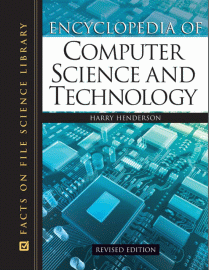
From School Library Journal
Grade 9 Up-In this A-to-Z resource, 400 mini essays are geared to students who want an overview of the topic, a discussion of its significance, and a guide to further reading. An introduction ends with a list of subject groupings of related entries such as "Computer Languages," "Business Applications," and "AI and Robotics." Biographies of historical figures such as Charles Babbage and Grace Hopper and modern visionaries like Bill Joy and Marvin Minsky are often accompanied by captioned photographs. Articles explain the role of "women in computing," "fuzzy logic," and "hypertext and hypermedia"; many entries are devoted to the future of computing and social issues such as intellectual property and privacy. Nearly every page contains a diagram, chart, or photograph. An illustration of the inner workings of a mouse and a simple graphic of computer animation are useful for students. More complex flowcharts explain database structure, HTML, and network systems. Appendixes list people who have received major awards in these fields and related organizations and include a chronology and a bibliography with Web resources. The general index is hierarchical and synonym rich. This solid resource succeeds in explaining technical aspects of these subjects to general readers.
Vicki Reutter, Cazenovia High School, NY
Copyright 2003 Reed Business Information, Inc. --This text refers to the Hardcover edition.
From Booklist
This encyclopedia focuses on computers and issues related to computers. More than 400 entries, arranged alphabetically, provide information on hardware, software, computer languages, operating systems, applications, the Internet, key individuals, and social issues such as the digital divide. With a limited number of entries, topic selection appears based on popularity. For example, Microsoft Windows gets a three-page main entry, while the Macintosh operating system is only mentioned within articles related to Macintosh (e.g., Jobs, Steven Paul).
Articles average about a page in length. The longest, History of computing, stretches to just over four pages. All articles have a list of further readings, usually two to eight items, often including Web sites. Citations for books and articles are current, with several from 2002.
Articles on various computer languages might be too technical for the novice computer user. For example, the article on C++ provides sample code. On the other hand, articles on hardware seem tailored for the beginner. Mouse traces the development of the mouse, includes a diagram of a mechanical mouse, and has statements such as "Activating a button is called clicking." As a result, both beginners and more experienced computer users should find this resource helpful.
The 167 black-and-white illustrations include charts, drawings, flowcharts, photographs, and screen shots. Four appendixes include a list of bibliographic guides (both print and Web based) to the computer field, a chronology of computing, important awards, and computer-related organizations. The encyclopedia also offers a listing of entries by general category in the front and a keyword index in the back.
Download Link:
Password default : booktraining.net
No comments:
Post a Comment